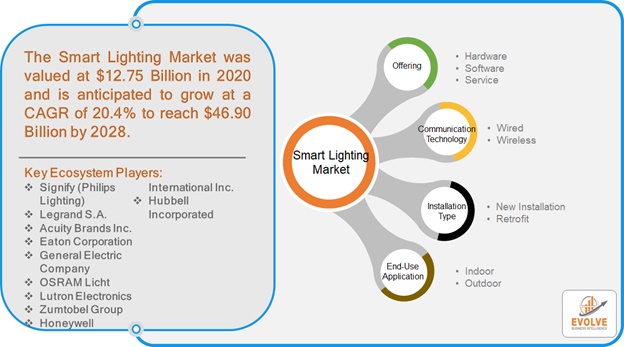The global Smart Lighting market size is projected to reach approximately $46.90 Billion by 2030, at a CAGR of 20.4% from 2022 to 2030. A lighting technology that has been designed for efficiency is known as smart lighting. Smart lighting consists of automated controls and high-efficiency fixtures that can be adjusted according to the condition such as daylight availability or occupancy. Smart lights are those which can be controlled wirelessly. The smart bulb can be controlled by a mobile device or a remote for example, increasing or decreasing the brightness level with just a touch of a button. The way a smart bulb works is it connects wirelessly to the next closest bulb using mesh networking.
COVID-19 Impact Analysis
Smart lighting was hit hardest in 2020 and 2021 due to the emergence of novel COVID-19 variants. GE Lighting, Acuity Brands, and Silver Spring Networks incurred significant financial losses because of this. However, the market has been growing significantly due to the new product launches by Original Equipment Manufacturers (OEMs). OEMs are expanding their dealer networks in under-utilized regions to increase perceived sales, thus speeding up market growth.
Global Smart Lighting Market Dynamics
The major drivers of the Smart Lighting Market are upcoming smart city projects in developing countries like India, integrated lighting control systems, integration of smart devices and lighting solutions, increasing awareness by the government and consumers about energy saving and how it will affect the planet and rising use coupled with falling prices of LED across the whole world.
Drivers
Ø Integration of Lighting Controls with Lamps and Luminaires
The biggest share in the Smart Lighting market during the forecast period is projected to be occupied by lights and luminaires. The reason behind this is the integration of lighting controls with lamps and luminaires. This integration allows the software to be embedded on microcontrollers which adds intelligence to the entire lighting control system. These lighting systems offer control and sensing at a special resolution and this is highly responsible for increasing the demand and accelerating the growth of the smart lighting market.
Restraint:
Ø Security Issues with IoT-based Lighting
The technology behind the Smart lights is becoming innovative and mainstream, embedded with wireless connectivity modules, sensors, and cameras. This ensures that all the data and information are stored in the cloud so that the user can access it from anywhere. Connected or smart lighting products are usually connected through the Internet. This creates a potential risk of being hacked, either ways of disabling these devices or accessing confidential data. For example, a hacker might gain remote access to a wireless network and then attempt to manipulate smart lighting control systems, door unlocking systems, security camera systems, and so on.
Opportunity:
⮚ Growing Demand for Energy-Efficient Lighting Systems
Companies across the market are currently in need of less energy-consuming technology. The demand for such technologies has a high volume in today’s market. Most systems are electronic or electrical and operate off power and energy sources. The depletion of these energy sources has caused more to be invested in the development of more energy-efficient systems. Smart lighting is a product that uses considerably less power than traditional lighting, which provides it with a good opportunity in the market.
Global Smart Lighting Market Segment Overview
By Offering
Based on the Offering, the Smart Lighting market is segmented based on Hardware, Software, and Service. The Hardware segment is anticipated to account for the large market share. The smart lighting Hardware segment has been further categorized into lamps and luminaires. The growth in this market is high during the forecast period due to their ability to integrate intelligence with lighting while reducing energy consumption. Hardware demand for connected lights is arising due to the popularity of connected lighting bulbs and fixtures that can change colors, dim light, and switch on/off using a controlling device such as a smartphone or tablet.
By Communication Technology
Based on the Communication Technology, the Smart Lighting market is segmented based on Wired and Wireless. The Wired segment is anticipated to account for the large market share. Wired technology is reliable and has several advantages. However, installing newer wiring and related hardware for old or existing buildings is a costly and time-consuming process. In recent years, people’s inclination to buy wireless technology has increased substantially.
By Installation Type
Based on Installation Type, the global Smart Lighting market has been divided into New installations and Retrofit. The New Installation segment is expected to hold the largest market share. New installations are projected to grow over the forecast timeline due to several factors such as their superior cost-effectiveness, use of newer technologies, and ease of installation. Wireless technology is very commonly used in these newer installation types.
By End-Use Application
Based on End-Use Application, the global Smart Lighting market has been divided into Indoor and Outdoor. The Indoor segment is expected to hold the largest market share. In recent years, the focus on green buildings and smart lights in APAC has gained momentum among companies. The growth will continue to rise in the coming years due to this shift. This would eventually lead to the growth of the indoor market for smart lighting. The commercial segment accounted for the largest share of the market in the segment.
Global Smart Lighting Market Share, by Segmentation

Global Smart Lighting Market Regional Analysis
Based on region, the global Smart Lighting market has been divided into North America, Europe, Asia-Pacific, and the Rest of the World. Europe is projected to dominate the use of the Smart Lighting market followed by the North America and Asia-Pacific regions.
Europe Market
The European region dominates the global Smart Lighting market owing to the constant rise in the standard of living in European countries. In addition to this, building automation in France, the United Kingdom, and Germany is a major contributing factor. According to the Global Lighting Association (GLA), LED luminaires account for the highest share of the smart lighting market in the European region.
Asia-Pacific Market
The Asia Pacific is expected to witness a significantly high growth rate during the forecast period. The contributing factor behind this growth is the large-scale adoption of Led lamps in the Asia-Pacific region. Government initiatives as well as rising industrialization and urbanization are major factors affecting the smart lighting market in this region.
Competitive Landscape
The market comprises tier-1, tier-2, and local players. With their wide product portfolios, tier-1 and tier-2 players have a global reach. Because of their strategic innovations and broad regional presence, companies such as Signify (Philips Lighting), Legrand S.A., Acuity Brands Inc., Eaton Corporation, Genera, Electric Company, OSRAM Light, Lutron Electronics, Zumtobel Group, Honeywell International Inc., Hubbell Incorporated, lead the global Smart Lighting business. To increase their market position and attract a wide consumer base, the businesses are employing various strategies, such as growth, product releases, and alliances.
Prominent Players:
- Signify (Philips Lighting)
- Legrand S.A.
- Acuity Brands Inc.
- Eaton Corporation
- General Electric Company
- OSRAM Licht
- Lutron Electronics
- Zumtobel Group
- Honeywell International Inc.
- Hubbell Incorporated
Scope of the Report
Global Smart Lighting Market, by Offering
- Hardware
- Software
- Service
Global Smart Lighting Market, by Communication Technology
- Wired
- Wireless
Global Smart Lighting Market, by Installation Type
- New Installation
- Retrofit
Global Smart Lighting Market, by End-Use Application
- Indoor
- Outdoor
Global Smart Lighting Market, by Region
- North America
- US
- Canada
- Mexico
- Europe
- UK
- Germany
- France
- Italy
- Rest of Europe
- Asia Pacific
- China
- Japan
- South Korea
- India
- Rest of Asia Pacific
- Rest of the World
| Parameters | Indicators |
|---|---|
| Market Size | 2030: $ 46.90 Billion |
| CAGR | 20.4% CAGR (2022-2030) |
| Base year | 2021 |
| Forecast Period | 2022-2030 |
| Historical Data | 2020 |
| Report Coverage | Revenue Forecast, Competitive Landscape, Growth Factors, and Trends |
| Key Segmentations | Offering, Communication Technology, Installation Type, and End-Use Application |
| Geographies Covered | North America, Europe, Asia-Pacific, Latin America, Middle East, Africa |
| Key Vendors | Signify (Philips Lighting), Legrand S.A., Acuity Brands Inc., Eaton Corporation, Genera, Electric Company, OSRAM Light, Lutron Electronics, Zumtobel Group, Honeywell International Inc., Hubbell Incorporated |
| Key Market Opportunities | Growing Demand for Energy-Efficient Lighting Systems |
| Key Market Drivers | Integration of Lighting Controls with Lamps and Luminaires |
REPORT CONTENT BRIEF:
- High-level analysis of the current and future Smart Lighting market trends and opportunities
- Detailed analysis of current market drivers, restraining factors, and opportunities in the future
- Smart Lighting market historical market size for the year 2020, and forecast from 2021 to 2028
- Smart Lighting market share analysis at each product level
- Competitor analysis with a detailed insight into its product segment, financial strength, and strategies adopted.
- Identifies key strategies adopted including product launches and developments, mergers and acquisitions, joint ventures, collaborations, and partnerships as well as funding taken and investment done, among others.
- To identify and understand the various factors involved in the global Smart Lighting market affected by the pandemic
To provide a detailed insight into the major companies operating in the market. The profiling will include the financial health of the company past 2-3 years with segmental and regional revenue breakup, product offering, recent developments, SWOT analysis, and key strategies.






